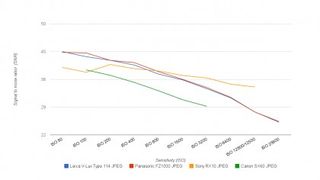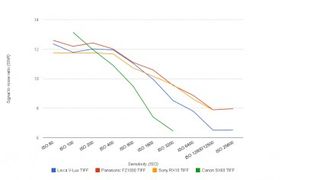Why you can trust TechRadar
We shoot a specially designed chart in carefully controlled conditions and the resulting images are analysed using DXO Analyzer software to generate the data to produce the graphs below.
The four rival cameras we chose for this comparison are the Panasonic FZ1000, Sony RX10 and Canon SX60 HS.
A high signal to noise ratio (SNR) indicates a cleaner and better quality image.
For more more details on how to interpret our test data, check out our full explanation of our noise and dynamic range tests.
JPEG dynamic range

Analysis: Interestingly, the dynamic range of the V-Lux (Typ 114) does differ from that of the Panasonic FZ1000, the camera it's based on – this seems to confirm our impression that there are differences in the image processing. At lower ISOs the Leica's performance is average and below the FZ1000's, but at ISO 1600 and beyond the tables are turned, and the V-Lux puts in the best performance.
Raw (converted to TIFF) dynamic range

Analysis: The RAW files tell a different story. Here, the figures for the Panasonic FZ1000 and Leica V-Lux are almost identical. All four cameras in this comparison show similar results at ISO 100-200, but beyond that the smaller sensor Canon falls away rapidly, as we would expect.
JPEG signal to noise ratio

Analysis: The three cameras with 1-inch sensors easily outperform the Canon SX60 HS, demonstrating the value of a larger sensor. The Sony proves better at handling noise in JPEG images at ISO 1600 and beyond, while the Panasonic and Leica produce identical results.
Raw (converted to TIFF) signal to noise ratio

Analysis: The signal to noise results are broadly the same for raw files, though here the Panasonic FZ1000 and Sony RX10 prove the most closely matched, with the Leica V-Lux falling slightly behind at higher ISOs. The Canon's data again shows the disadvantages of a small sensor.
Current page: Noise and dynamic range
Prev Page Image quality and resolution Next Page Sensitivity and noise images
Intel unveils flurry of new Arc GPUs — however serious graphics users will have to wait for more powerful models, as these focus on a completely different and more lucrative market

We just got another hint that the Samsung Galaxy Watch 7 is almost here

Visible Plus is one of the best cheap cell phone plans - and it just got even better
